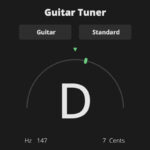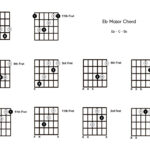Tuning your guitar a half step down, also known as Eb Standard tuning, is a widely embraced technique by guitarists across various musical genres. This method involves decreasing the pitch of each string by a semitone, resulting in a deeper, richer tone, enhanced playability, and better compatibility with a singer’s vocal range. This article will guide you through the process of tuning your guitar a half step down, both with and without a tuner, and provide valuable insights for playing in this versatile tuning.
For guitarists eager to explore new sonic territories and alternative tunings like half-step down, platforms such as Rocksmith+ offer a wealth of resources. Rocksmith+ includes a built-in chromatic tuner and an expansive library of over 7,000 songs, many of which are in Eb Standard tuning. Let’s delve into the advantages of tuning your guitar a half step down and how to achieve it effectively.
Why Tune Down Half a Step? Exploring the Benefits
Tuning your guitar down by a half step offers a range of advantages, making it a favored choice for guitarists of all skill levels and musical preferences. Let’s explore the key reasons why you might consider tuning your guitar to Eb Standard:
Enhanced Playability
Reducing the tension of the strings by tuning down a half step can significantly improve playability, especially when executing complex chords, bends, and other techniques. This is particularly beneficial for beginner guitarists or those using resources like Rocksmith+ as their primary learning tool. Less string tension can make learning easier and reduce finger strain.
Richer, Warmer Tonal Quality
Half-step down tuning imparts a subtly deeper and warmer tone to your guitar’s sound. This sonic characteristic is particularly sought after in genres like blues, rock, and metal. The slightly lower pitch can add depth and character to your playing, helping you carve out a distinctive sound.
Vocal Range Accommodation
For singer-songwriters or guitarists who enjoy singing while playing, tuning down a half step can be a game-changer. Lowering the overall pitch of your guitar music can make it easier to sing comfortably within your natural vocal range. This adjustment can be crucial for vocal performances and practice sessions.
Playing Along with Songs in Eb Tuning
A vast number of popular songs across various genres have been originally recorded in Eb Standard tuning. If you want to accurately play along with these songs, tuning your guitar down a half step is often necessary. Rocksmith+, with its extensive library of over 7,000 songs, provides ample opportunities to practice and learn songs in Eb tuning.
Sparking Creativity
Experimenting with different tunings, including half-step down, can be a powerful catalyst for creativity. Venturing into Eb Standard tuning might unlock new songwriting ideas and inspire you to explore uncharted musical territories. The change in pitch can shift your perspective and lead to fresh musical discoveries.
How to Tune Your Guitar Half Step Down Using a Tuner: A Step-by-Step Guide
To tune your guitar a half step down accurately, using a tuner is highly recommended. This tuning, also referred to as Eb tuning or E flat tuning, involves lowering each string’s pitch by one semitone. Utilizing a tuner, such as those found in alternative tuning apps or the chromatic tuner within the Rocksmith Tuner app, ensures precision and ease in the process.
Follow these steps to tune your guitar to Eb Standard using a tuner:
-
Start with the 6th String (Low E): Begin with the thickest string, which is the 6th string (low E in standard tuning). Tune it down until your tuner registers Eb or D#. The note you’re aiming for is a half step lower than standard E.
-
Tune the 5th String (A): Move to the 5th string (A in standard tuning) and tune it down to Ab or G#. Again, this is a half step lower than standard A.
-
Tune the 4th String (D): Proceed to the 4th string (D in standard tuning) and tune it down to Db or C#. Ensure it is a half step below standard D.
-
Tune the 3rd String (G): Tune the 3rd string (G in standard tuning) down to Gb or F#. This string also needs to be lowered by a half step.
-
Tune the 2nd String (B): Lower the 2nd string (B in standard tuning) to Bb or A#. Tune it down a half step from standard B.
-
Tune the 1st String (High E): Finally, tune the thinnest string, the 1st string (high E in standard tuning), down to Eb or D#. This completes the half-step down tuning process.
Tuning a Half Step Down Without a Tuner: Relative Tuning Method
If you find yourself without a tuner, you can still tune your guitar a half step down using relative tuning. This method relies on your ear and the established pitch relationships between the guitar strings. However, it’s crucial to remember that this method’s accuracy depends on your ear training and a reference pitch.
Here’s how to tune to Eb Standard without a tuner using relative tuning:
-
Start with the 6th String (Low E) as a Reference: Begin with your low E string (6th string). Fret the 6th string at the 6th fret. In standard tuning, this fret would produce an A# (Bb) note. Loosen the 6th string until the note produced at the 6th fret sounds like an A note. This ‘A’ should match the open 5th string’s standard A pitch. You’ve now effectively tuned your 6th string down a half step to Eb.
-
Follow the 5-5-5-4-5 Tuning Pattern (Adjusted for Eb): Now, use the following pattern, remembering your 6th string is now Eb:
- 5th String: Fret the 5th fret of the newly tuned 6th string (Eb). This fret will now produce an Ab note. Tune your open 5th string to match this Ab note.
- 4th String: Fret the 5th fret of the 5th string (Ab). This fret will now produce a Db note. Tune your open 4th string to match this Db note.
- 3rd String: Fret the 5th fret of the 4th string (Db). This fret will now produce a Gb note. Tune your open 3rd string to match this Gb note.
- 2nd String: Fret the 4th fret of the 3rd string (Gb). This fret will now produce a Bb note. Tune your open 2nd string to match this Bb note. (Note the 4th fret here, not the 5th).
- 1st String: Fret the 5th fret of the 2nd string (Bb). This fret will now produce an Eb note. Tune your open 1st string to match this Eb note.
Important Note on Accuracy: Relative tuning without a reference pitch for the initial Eb can lead to inaccuracies. If your starting 6th string is not precisely tuned to Eb, the entire guitar will be relatively in tune with itself but potentially off-pitch overall. While this might sound acceptable when playing alone, it can clash when playing with other instruments tuned to standard pitch.
For optimal accuracy and a more enjoyable playing experience, it’s highly recommended to use a tuner. Consider downloading the free Rocksmith Tuner app on your smartphone for precise and convenient tuning.
Embrace the Half Step Down Tuning
Tuning your guitar down a half step is a fantastic way to broaden your sonic palette and unlock new musical avenues. This tuning offers a slightly deeper and warmer tone, which can amplify the emotional resonance of your guitar playing. It’s particularly useful for playing along with songs originally recorded in Eb Standard or for vocalists seeking a more comfortable singing range.
Whether you are a beginner or an experienced guitarist, experimenting with half-step down tuning can inject a refreshing dimension into your playing. So, give Eb Standard tuning a try and remember to enjoy the process of learning and exploring new musical horizons, perhaps with resources like Rocksmith+ to guide your journey.
Sources:
Understanding Vocal Range, Vocal Registers, and Voice Type: A Glossary of Vocal Terms | SingWise
Find Your Vocal Range | Ramsey Voice Studio
Music Mood Classification | Electrical and Computer Engineering Design Handbook


